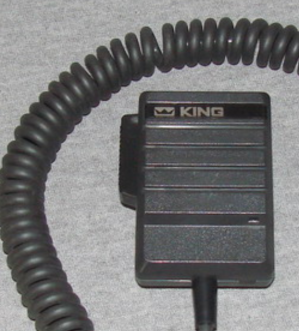As our work on the 2017 Annual Incident Review Summary continues, we’ve got some more analysis to share with you. Read this. Do the Exercise, and give us some feedback. The final version of the 2017 Annual Incident Review Summary will be out soon!
By Travis Dotson
You got a mic? Are you a wrapper?
Ha Ha – lots of people didn’t get that.
Rewind:
- Do you have an external microphone for your radio? (“mic”)
- Do you wrap the cord through the webbing on your line pack? (“wrapper”)
See how it’s not funny when I explain it?
What the hell am I even talking about?

An External Radio Mic
I’m talking about needing to ditch your gear, grab your radio, and run for your life. See, that’s where the mic cord becomes a problem. The problem is when you are trying to escape from a wall of flame bearing down on you it can get hard to do things – especially things that need to be done fast. Fiddling with intricate little parts is a giant pain in the ass – especially with gloves on, and when it’s hot and you know with more intensity than you ever have that the smallest delay is deadly. Literally deadly.
You know where I’m going. It turns out it’s rather difficult to ditch your gear, grab your shelter, radio, and water when your radio mic is woven through the gear you are trying to ditch.
For those of you who are thinking “just don’t weave the cord, let it hang loose” – you might never have tried to actually work, especially in brush, with a loose cord dangling here and there. The environment we operate in is mean. It turns out trees, brush, tools…even rocks, all have deceptively intense grip, strength, reach, and are plain old sneaky as shit. That cord will be grabbed and held when and where you least expect it. This is why we invest so much attention in a tightly woven cord. We are trying to outwit the wrathful reach of that vengeful vegetation.
Yes, the mic cord is intentionally woven tight for good reason. But that good reason gets tangled up with survival in certain situations.
Check it out:
From the 2012 Holloway Entrapment report: “Firefighter A moves into the only opening she can see, removes her pack, gloves, then removes the fire shelter, discards her fuel bottle, and attempts to remove the radio and water from pack. She has difficulty retrieving the radio due to the remote microphone cord being intertwined in the line pack webbing.”
From the 2017 Preacher Fire Entrapment report: “Iron Mountain lookout was trained to drop line gear to lighten his load. He knew he needed to take his radio, fire shelter and hand tool. He threw his line gear on the upper cut bank of the road to remove his equipment. The cord to his external speaker mic was woven into the webbing of his line gear, which is something that many firefighters do to keep the cord out of the way. The urgency of the situation made it even more difficult to disconnect his radio mic. He felt it took an extraordinary amount of time and was extremely frustrated when he finally removed the radio from his line gear.”
See the problem? Pretty straightforward. When you are running for your life and go to ditch your gear but want to keep your radio (as you were trained) that external mic can be a real time sink, and you got no time to sink.
So what to do? Figure it out yourself. I’m not trying to be an ass. I just know we are a bunch of inventive bunnies and we put a lot of stock in things we come up with ourselves which means you are likely much better served if you customize a solution that works for you. So go do it.
You just got served (a lesson that is).

Exercise (30 minutes)
- Gather up with a few other folks who carry radios. Discuss the practice of “weaving your mic cord” through pack webbing.
- What are the pros and cons? (10 mins)
- Identify 3 ways to avoid the cord problem from the entrapment fires listed above. (10 mins)
- Decide as a group if there is a reason to make a rule about this type of cord set-up? (Take a vote if you need to.) (10 mins)
Go get your gear if you need to make changes.


I can see your point on this mic cord issue. I run a private contract fire crew. Yes the cord can be a big pain. I have 12 BKs and a six man team. Each team member has a radio on them at all times. We took care of the mic cord and mic. We now have headphones and mic. I had the cords shortened so we don’t have the cord problem. Maybe more departments will change.
LikeLike
I was thinking allot about this problem this past season. When I mentioned the issue to some fellow saws, I got the *shrug* “that’s just how it is always done, chestrigs are type 2 AF”. I am planning on experimenting with with a low-pro chest mounted solution this year during preseason training hikes, and if authorized during the season itself. The version that I have is made by Hill People Gear, a small outdoor equipment design house founded and run by former and current Hotshots (fwtiw). I have worn it when hunting keep basics and a bear pistol on my person and off the legs and waist. In this roll I have had nothing but good experience in both comfort and function.
Anyway, thanks for opening this convo. I am deeply grateful for what y’all contribute to the communty.
[For a context disclaimer, my experience is as a second year sawyer on an agency handcrew working ~1K hours OT last season with ~80 days out of state. In other words, only enough experience to have some half-formed notions and f**k up allot.
LikeLiked by 1 person
This past summer I worked with Astra Radio Communications (ARC) to have them build a Bluetooth Speaker Microphone Kit for the KNG-P150s model radio. The first prototype shipped to me and I went out on a Type 2 team and had a few crews Test and Evaluate the Kit. The response was favorable, and they are now in production and available for Federal Agency crews for $220/each.
The Kit includes: Bluetooth Speaker Microphone with SSP, 2500mAh rechargeable battery rated @ 10hr continuous operation time (200 hour standby time), and is IP54 rated water resistant; A Bluetooth ‘dongle’ that connects to the side port of the radio; and a tactical earpiece.
For more information or if you are interested in purchasing the Bluetooth Speaker Mic Kit for the KNG-P150s model radio – visit: http://www.arcmic.com or call 1.877.881.5858
For crews running the KNG2-P150 model radio, there are Bluetooth Speaker Mics available on the market to sync with that model’s built-in Bluetooth radio.
Innovation is earned by making mistakes and having the grit to try and make things better for your peers.
LikeLike
Now I have little wild land fire experience, but a lot of shipboard fire training and experience, with that said, what I’m about to say may be a good solution to this entanglement issue, it may not. My experience comes mostly from military service, as a coms specialist for several high speed low drag military teams, along with damage control training. So let me tell you that the Mic cord issue is a real problem for everyone that has ever been in a flee for your life situation. We figured out that using a longer mic cord, with belt holsters for the radios, and running the mic cord between the undershirt and over shirt, up the back, over the shoulder, and out between the second and third button hole, attaching the mic at the place between the first and second buttons on the flap eliminated 99% of the cord issues we faced. I think this may be some thing to look into for you guys as well. We also used throat mics in some situations, running the cord in the same fashion as stated earlier, except the cord came to the shoulder and didn’t need weaving in and out of the buttoned up outer layer. Hope this may help.
LikeLiked by 1 person